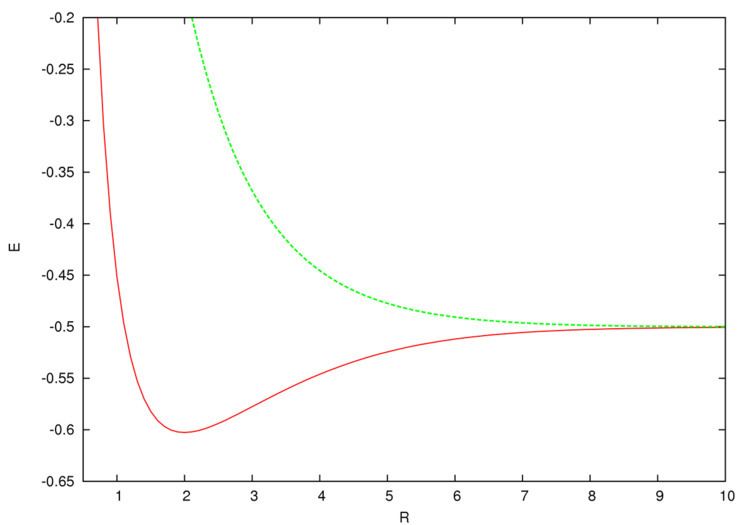 | ||
The Holstein–Herring method, also called the Surface Integral method, also called Smirnov's method is an effective means of getting the exchange energy splittings of asymptotically degenerate energy states in molecular systems. Although the exchange energy becomes elusive at large internuclear systems, it is of prominent importance in theories of molecular binding and magnetism. This splitting results from the symmetry under exchange of identical nuclei (Pauli Exclusion Principle).
Contents
Theory
The basic idea pioneered by Holstein and Herring approach can be illustrated for the hydrogen molecular ion or more generally, atom-ion systems or one-active electron systems, as follows. We consider states that are represented by even or odd functions with respect to behavior under space inversion. This is denoted with the suffixes g and u from the German gerade and ungerade and are standard practice for the designation of electronic states of diatomic molecules, whereas for atomic states the terms even and odd are used. The electronic Schrödinger equation can be written as:
where E is the (electronic) energy of a given quantum mechanical state (eigenstate), with the electronic state function
For any gerade (or even) state, the electronic Schrödinger wave equation can be written in atomic units (
For any ungerade (or odd) state, the corresponding wave equation can be written as:
For simplicity, we assume real functions (although the result can be generalized to the complex case). We then multiply the gerade wave equation by
where
This is similar to the LCAO (Linear Combination of Atomic Orbitals) ansatz used in quantum chemistry, but we emphasize that the functions
This implies that:
Also, these localized functions are normalized, which leads to:
and conversely. Integration of the above in the whole space left to the mid-plane yields:
and
From a variation of the divergence theorem on the above, we finally obtain:
where
Previous calculations based on the LCAO of atomic orbitals had erroneously given a lead coefficient of
Applications
The Holstein-Herring formula had limited applications until around 1990 when Tang, Toennies, and Yiu demonstrated that
The outcome meant that it was possible to solve for the asymptotic exchange energy splittings to any order. The Holstein–Herring method has been extended to the two-active electron case i.e. the hydrogen molecule for the two lowest discrete states of
Physical Interpretation
The Holstein–Herring formula can be physically interpreted as the electron undergoing "quantum tunnelling" between both nuclei, thus creating a current whose flux through the mid-plane allows us to isolate the exchange energy. The energy is thus shared, i.e. exchanged, between the two nuclear centers. Related to the tunnelling effect, a complementary interpretation from Sidney Coleman's "Aspects of Symmetry" (1985) has an "instanton" travelling near and about the classical paths within path integral formulation. Note that the volume integral in the denominator of the Holstein-Herring formula is sub-dominant in
